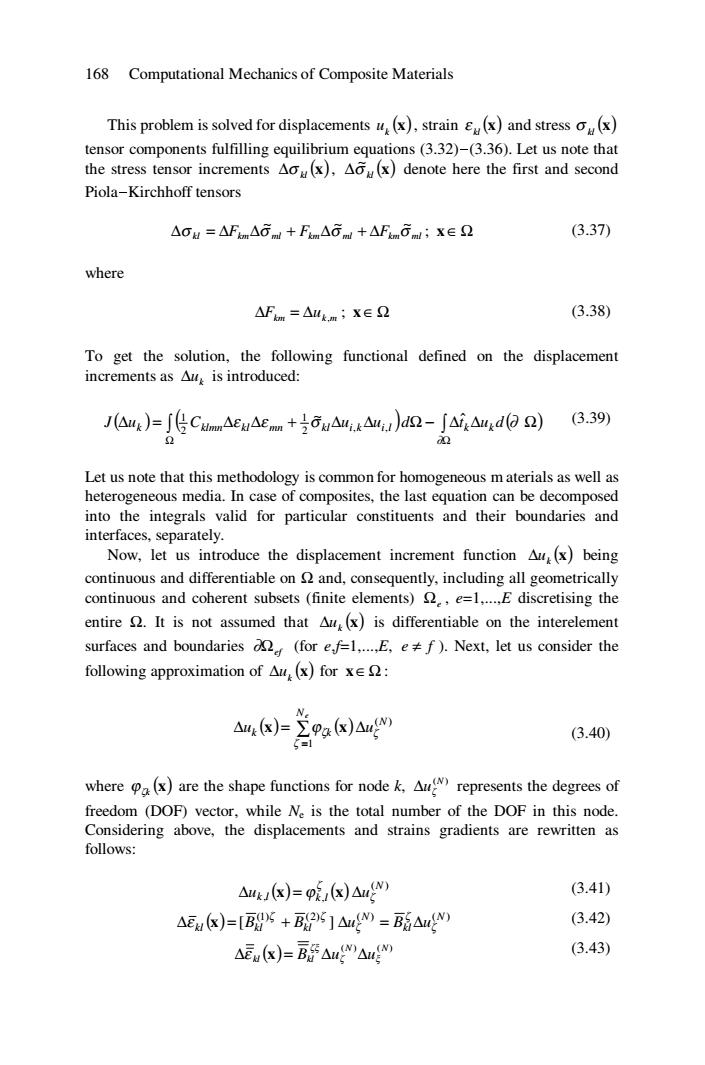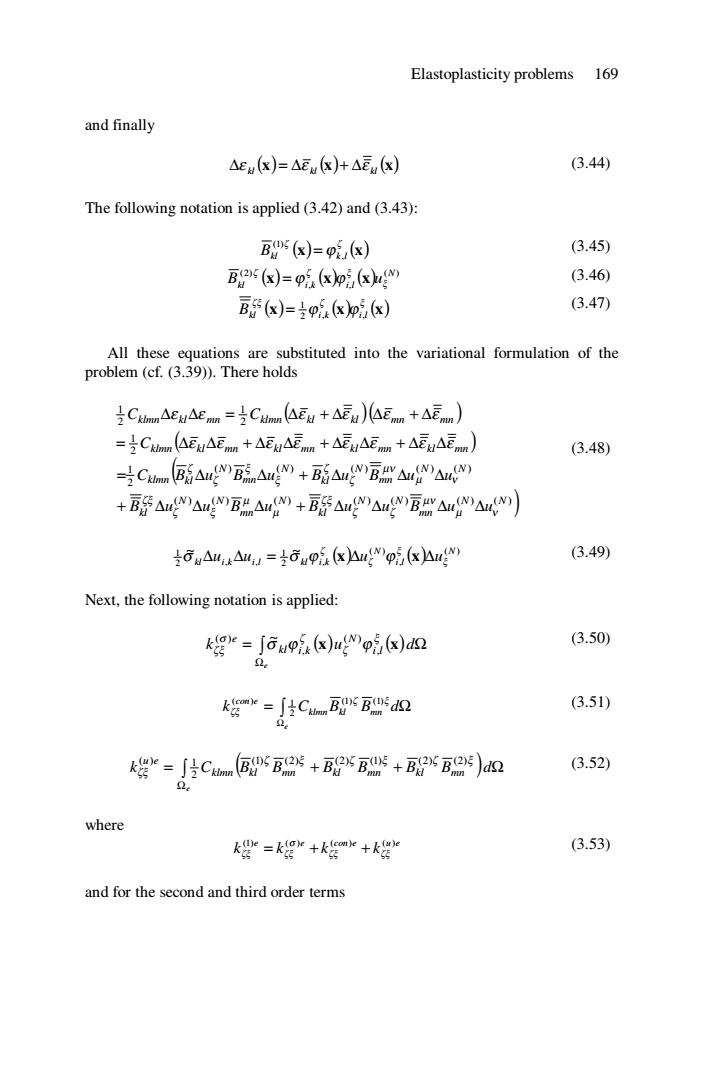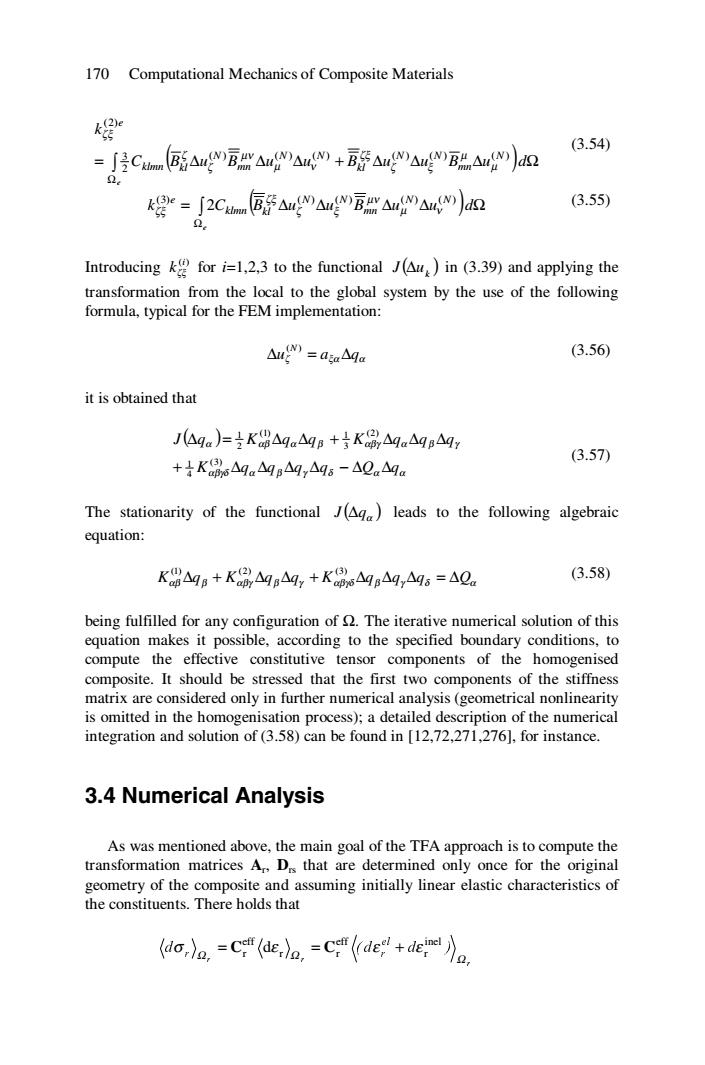
168 Computational Mechanics of Composite Materials This problem is solved for displacements u(x),strain Ex)and stress ox) tensor components fulfilling equilibrium equations(3.32)-(3.36).Let us note that the stress tensor increments Ao(x),Ad(x)denote here the first and second Piola-Kirchhoff tensors △oH=△Fm△dnm+fFm△Gnm+△FOm;x∈2 (3.37) where △Fm=△lkm;X∈2 (3.38) To get the solution,the following functional defined on the displacement increments as Au is introduced: JAue)=∫CumAE△emn+ouA:kAu:u)dQ-∫△ieAu:d旧D (3.39) Let us note that this methodology is common for homogeneous m aterials as well as heterogeneous media.In case of composites,the last equation can be decomposed into the integrals valid for particular constituents and their boundaries and interfaces,separately. Now,let us introduce the displacement increment function Au(x)being continuous and differentiable on and,consequently,including all geometrically continuous and coherent subsets (finite elements).,e=1,...,E discretising the entire It is not assumed that Au(x)is differentiable on the interelement surfaces and boundaries (for ef=1.....,ef).Next,let us consider the following approximation of Au(x)for xe: Ne Au:x)=paK)△ (3.40) =1 wherex)are the shape functions for node k.Au)represents the degrees of freedom (DOF)vector,while Ne is the total number of the DOF in this node. Considering above,the displacements and strains gradients are rewritten as follows: Ak()=p(x)△n (3.41) △EuK)=[+B]△”=略△ (3.42) △Eu(K)=B△u△n (3.43)
168 Computational Mechanics of Composite Materials This problem is solved for displacements ( ) x k u , strain ( ) x kl ε and stress ( ) x σ kl tensor components fulfilling equilibrium equations (3.32)-(3.36). Let us note that the stress tensor increments ( ) x ∆σ kl , ( ) x σ kl ~ ∆ denote here the first and second Piola-Kirchhoff tensors σ kl Fkm σ ml Fkm σ ml Fkmσ ml ~ ~ ~ ∆ = ∆ ∆ + ∆ + ∆ ; x ∈Ω (3.37) where ∆Fkm = ∆uk ,m ; x ∈Ω (3.38) To get the solution, the following functional defined on the displacement increments as k ∆u is introduced: ( ) ( ) ( ) ∫ ∫ Ω Ω ∆ = ∆ ∆ + ∆ ∆ Ω − ∆ ∆ Ω ∂ J uk Cklmn ε kl ε mn σ kl ui k ui l d t ˆ k ukd ∂ ~ 2 , , 1 2 1 (3.39) Let us note that this methodology is common for homogeneous m aterials as well as heterogeneous media. In case of composites, the last equation can be decomposed into the integrals valid for particular constituents and their boundaries and interfaces, separately. Now, let us introduce the displacement increment function ( ) x k ∆u being continuous and differentiable on Ω and, consequently, including all geometrically continuous and coherent subsets (finite elements) Ωe , e=1,...,E discretising the entire Ω. It is not assumed that ( ) x k ∆u is differentiable on the interelement surfaces and boundaries ∂Ωef (for e,f=1,...,E, e ≠ f ). Next, let us consider the following approximation of ( ) x k ∆u for x∈Ω : () () ( ) 1 N N uk k u e ζ ζ ∆ = ∑ϕζ ∆ = x x (3.40) where ϕζk ( ) x are the shape functions for node k, (N ) ∆uζ represents the degrees of freedom (DOF) vector, while Ne is the total number of the DOF in this node. Considering above, the displacements and strains gradients are rewritten as follows: () () ( ) , , N k l k l u uζ ζ ∆ x = ϕ x ∆ (3.41) ( ) (1) (2) ( ) ( ) [ ] N kl N kl kl kl B B u B uζ ζ ζ ζ ζ ∆ε x = + ∆ = ∆ (3.42) ( ) (N ) (N) kl Bkl uζ uξ ζξ ∆ε x = ∆ ∆ (3.43)

Elastoplasticity problems 169 and finally △eH(x)=△Eu&)+△Eu(x) (3.44) The following notation is applied (3.42)and (3.43): Bx)=p{(&) (3.45) B2s(区)=p&p(xg (3.46) B(x)=xi(x) (3.47) All these equations are substituted into the variational formulation of the problem(cf.(3.39)).There holds 3Chn△Eu△emn=Chmm△Eu+△Eu)△Em+△Enm) =Cklmn (AEgAEmn+△Eu△E,n+△Eu△Emm+AEgAEmn) (3.48) =号Chn⑧i△nB点An”+略AnB△△ +B5△△BA”+BfA△n△A) 6u△lu△4u=6up(K△upi(xAu (3.49) Next,the following notation is applied: kge=∫6up(ug9i(aa2 (3.50) 2 kg=∫CumB Bd2 (3.51) 42 k号=∫分Cmn®2+2S+2Ba)dn (3.52) 2 where 缨=kg+k+k号 (3.53) and for the second and third order terms
Elastoplasticity problems 169 and finally ( ) x ( ) x ( ) x kl kl kl ∆ε = ∆ε + ∆ε (3.44) The following notation is applied (3.42) and (3.43): () () x x ζ ζ Bkl ϕk ,l (1) = (3.45) () () () ( ) , , (2) N kl i k i l B uξ ζ ζ ξ x = ϕ x ϕ x (3.46) ( ) x () () x x ζξ ζ ξ Bkl 2 ϕi,k ϕi,l 1 = (3.47) All these equations are substituted into the variational formulation of the problem (cf. (3.39)). There holds ( )( ) ( ) ( ) ( ) ( ) ( ) ( ) ( ) ( ) ( ) ( ) ( ) ( ) ( ) ( ) 2 1 2 1 2 1 2 1 N N mn N N kl N mn N N kl N N mn N kl N mn N klmn kl klmn kl mn kl mn kl mn kl mn klmn kl mn klmn kl kl mn mn B u u B u B u u B u u C B u B u B u B u u C C C µ ν µν ζ ζ ζξ µ µ ζ ξ ζξ µ ν µν ζ ζ ξ ξ ζ ζ ε ε ε ε ε ε ε ε ε ε ε ε ε ε + ∆ ∆ ∆ + ∆ ∆ ∆ ∆ = ∆ ∆ + ∆ ∆ ∆ = ∆ ∆ + ∆ ∆ + ∆ ∆ + ∆ ∆ ∆ ∆ = ∆ + ∆ ∆ + ∆ (3.48) () () ( ) , ( ) 2 , 1 2 , , 1 ~ ~ N i l N kl i k i l kl i k u u u uξ ξ ζ ζ σ ∆ ∆ = σ ϕ x ∆ ϕ x ∆ (3.49) Next, the following notation is applied: () () ∫ Ω = Ω e k u d i l N kl i k e x x ξ ζ σ ζ ζξ σ ϕ ϕ , ( ) , ( ) ~ (3.50) ∫ Ω = Ω e k CklmnBkl Bmn d con e ζ ξ ζξ (1) (1) 2 ( ) 1 (3.51) ∫ ( ) Ω = + + Ω e k C B B B B B B d klmn kl mn kl mn kl mn u e ζ ξ ζ ξ ζ ξ ζξ (1) (2) (2) (1) (2) (2) 2 ( ) 1 (3.52) where e e con e u e k k k k (1) ( ) ( ) ( ) ζξ ζξ σ ζξ = ζξ + + (3.53) and for the second and third order terms

170 Computational Mechanics of Composite Materials (3.54) =J房Cm@号△△ArW+Bf△A△d k2=∫2Chn同△n△△r△)a (3.55) Ω Introducingk for i=1,2.3 to the functional (Au)in(3.39)and applying the transformation from the local to the global system by the use of the following formula,typical for the FEM implementation: △ng=asa△qa (3.56) it is obtained that J△qa)=Kw△qa△qB+K编△qa△qB△q7 (3.57) +tKs△qa△qB△q,△qs-△0.△ga The stationarity of the functional /(Ada)leads to the following algebraic equation: Kw△qB+KAqB△q,+Ks△qB△q,Aq6=△0 (3.58) being fulfilled for any configuration of The iterative numerical solution of this equation makes it possible,according to the specified boundary conditions,to compute the effective constitutive tensor components of the homogenised composite.It should be stressed that the first two components of the stiffness matrix are considered only in further numerical analysis(geometrical nonlinearity is omitted in the homogenisation process);a detailed description of the numerical integration and solution of (3.58)can be found in [12,72,271,276],for instance. 3.4 Numerical Analysis As was mentioned above,the main goal of the TFA approach is to compute the transformation matrices A,,Ds that are determined only once for the original geometry of the composite and assuming initially linear elastic characteristics of the constituents.There holds that (da,=C(de,)C(des+de)
170 Computational Mechanics of Composite Materials ( ) ∫ Ω = ∆ ∆ ∆ + ∆ ∆ ∆ Ω e C B u B u u B u u B u d k N mn N N kl N N mn N klmn kl e ( ) ( ) ( ) ( ) ( ) ( ) 2 3 (2) µ µ ζ ξ ζξ µ ν µν ζ ζ ζξ (3.54) ∫ ( ) Ω = ∆ ∆ ∆ ∆ Ω e k C B u u B u u d N N mn N N klmn kl (3)e ( ) ( ) ( ) ( ) 2 µ ν µν ζ ξ ζξ ζξ (3.55) Introducing (i) kζξ for i=1,2,3 to the functional ( ) k J ∆u in (3.39) and applying the transformation from the local to the global system by the use of the following formula, typical for the FEM implementation: uζ aξα qα N ∆ = ∆ ( ) (3.56) it is obtained that ( ) αβγδ α β γ δ α α α αβ α β αβγ α β γ K q q q q Q q J q K q q K q q q + ∆ ∆ ∆ ∆ − ∆ ∆ ∆ = ∆ ∆ + ∆ ∆ ∆ (3) 4 1 (2) 3 (1) 1 2 1 (3.57) The stationarity of the functional ( ) α J ∆q leads to the following algebraic equation: Kαβ∆qβ + Kαβγ∆qβ∆qγ + Kαβγδ∆qβ∆qγ∆qδ = ∆Qα (1) (2) (3) (3.58) being fulfilled for any configuration of Ω. The iterative numerical solution of this equation makes it possible, according to the specified boundary conditions, to compute the effective constitutive tensor components of the homogenised composite. It should be stressed that the first two components of the stiffness matrix are considered only in further numerical analysis (geometrical nonlinearity is omitted in the homogenisation process); a detailed description of the numerical integration and solution of (3.58) can be found in [12,72,271,276], for instance. 3.4 Numerical Analysis As was mentioned above, the main goal of the TFA approach is to compute the transformation matrices Ar, Drs that are determined only once for the original geometry of the composite and assuming initially linear elastic characteristics of the constituents. There holds that r r r d ( d d ) el r r Ω Ω Ω σ ε ε εinel r eff r r eff r = C d = C +